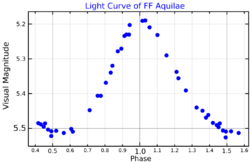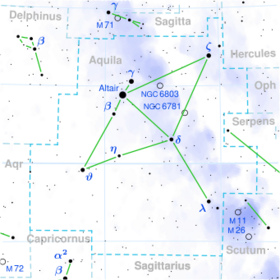Astronomy:FF Aquilae
| Observation data Equinox J2000.0]] (ICRS) | |
|---|---|
| Constellation | Aquila |
| Right ascension | 18h 58m 14.74830s[1] |
| Declination | +17° 21′ 39.2976″[1] |
| Apparent magnitude (V) | 5.18 - 5.51[2] |
| Characteristics | |
| Spectral type | F6Ib[3] |
| U−B color index | 0.43[4] |
| B−V color index | 0.8[4] |
| Variable type | δ Cep[2] |
| Astrometry | |
| Radial velocity (Rv) | −15.47±1.61[1] km/s |
| Proper motion (μ) | RA: −1.151[1] mas/yr Dec.: −9.823[1] mas/yr |
| Parallax (π) | 1.9057 ± 0.0712[1] mas |
| Distance | 1,710 ± 60 ly (520 ± 20 pc) |
| Absolute magnitude (MV) | −3.4[5] |
| Details | |
| Mass | 3.2[6] M☉ |
| Radius | 39[5] R☉ |
| Luminosity | 2,238[7] L☉ |
| Surface gravity (log g) | 1.28[8] cgs |
| Temperature | 6,195[5] K |
| Metallicity [Fe/H] | +0.04[9] dex |
| Rotational velocity (v sin i) | 10.0[10] km/s |
| Age | 60[9] Myr |
| Other designations | |
| Database references | |
| SIMBAD | data |
FF Aquilae is a classical Cepheid variable star located in the constellation Aquila. It ranges from apparent magnitude 5.18 to 5.51 over a period of 4.470848 days,[2] meaning it is faintly visible to the unaided eye in rural or suburban settings.[11]

Originally known as HR 7165, it was noted to be variable by Charles Morse Huffer in August 1927, who observed its Cepheid pattern. It then received the variable star designation FF Aquilae.[13] Analysis of its brightness over 122 years shows that its period is increasing by 0.072±0.011 seconds per year.[14] It is a small amplitude classical Cepheid, and as such is expected to be a supergiant near the red edge of the instability strip.[2]
A yellow supergiant, FF Aqlilae pulsates with varying temperature, diameter, and luminosity.[5] It has been estimated to be 1,710 ± 60 light-years (520 ± 20 parsecs) distant from Earth by extrapolating from its angular diameter and estimated radius.[5]
FF Aquilae is a possible quadruple star system. Analysis of its spectrum shows that it is a spectroscopic binary system with the fainter companion calculated to be a main sequence star of spectral type A9V to F3V, orbiting every 3.92 years. A third star, revealed by speckle interferometry, is likely to be a cooler star that has evolved off the main sequence.[15] A fourth star, that is of magnitude 11.4 and located 6 arcseconds away, is a somewhat evolved star slightly hotter, larger, and more luminous than the Sun.[16] Several studies found it unlikely to be a member of the system,[6][17] although Gaia Data Release 3 finds it to be at a similar distance and with a similar proper motion.[16]
References
- ↑ 1.0 1.1 1.2 1.3 1.4 1.5 Vallenari, A. et al. (2022). "Gaia Data Release 3. Summary of the content and survey properties". Astronomy & Astrophysics. doi:10.1051/0004-6361/202243940 Gaia DR3 record for this source at VizieR.
- ↑ 2.0 2.1 2.2 2.3 Watson, Christopher (4 January 2010). "FF Aquilae". AAVSO Website. American Association of Variable Star Observers. http://www.aavso.org/vsx/index.php?view=detail.top&oid=1309.
- ↑ Abt, Helmut A. (2009). "MK Classifications of Spectroscopic Binaries". The Astrophysical Journal Supplement 180 (1): 117–118. doi:10.1088/0067-0049/180/1/117. Bibcode: 2009ApJS..180..117A.
- ↑ 4.0 4.1 Ducati, J. R. (2002). "VizieR Online Data Catalog: Catalogue of Stellar Photometry in Johnson's 11-color system". CDS/ADC Collection of Electronic Catalogues 2237: 0. Bibcode: 2002yCat.2237....0D.
- ↑ 5.0 5.1 5.2 5.3 5.4 Turner, D. G.; Kovtyukh, V. V.; Luck, R. E.; Berdnikov, L. N. (2013). "The Pulsation Mode and Distance of the Cepheid FF Aquilae". The Astrophysical Journal 772 (1): L10. doi:10.1088/2041-8205/772/1/L10. Bibcode: 2013ApJ...772L..10T.
- ↑ 6.0 6.1 Gallenne, A.; Kervella, P.; Mérand, A.; Evans, N. R.; Girard, J. H. V.; Gieren, W.; Pietrzyński, G. (2014). "Searching for visual companions of close Cepheids". Astronomy & Astrophysics 567: A60. doi:10.1051/0004-6361/201423872. Bibcode: 2014A&A...567A..60G.
- ↑ Groenewegen, M. A. T. (2020). "The flux-weighted gravity-luminosity relation of Galactic classical Cepheids". Astronomy and Astrophysics 640: A113. doi:10.1051/0004-6361/202038292. Bibcode: 2020A&A...640A.113G.
- ↑ Stassun, Keivan G.; Oelkers, Ryan J.; Pepper, Joshua et al. (20 August 2018). "The TESS Input Catalog and Candidate Target List". The Astronomical Journal 156 (3): 102. doi:10.3847/1538-3881/aad050. Bibcode: 2018AJ....156..102S.
- ↑ 9.0 9.1 Acharova, I. A. et al. (2012). "Galactic restrictions on iron production by various types of supernovae". Monthly Notices of the Royal Astronomical Society 420 (2): 1590. doi:10.1111/j.1365-2966.2011.20161.x. Bibcode: 2012MNRAS.420.1590A.
- ↑ De Medeiros, J. R.; Alves, S.; Udry, S.; Andersen, J.; Nordström, B.; Mayor, M. (January 2014). "A catalog of rotational and radial velocities for evolved stars: V. Southern stars⋆⋆⋆". Astronomy & Astrophysics 561: A126. doi:10.1051/0004-6361/201220762. ISSN 0004-6361. Bibcode: 2014A&A...561A.126D.
- ↑ Bortle, John E. (2001). "Introducing the Bortle Dark-Sky Scale". Sky and Telescope 101 (2): 126. Bibcode: 2001S&T...101b.126B.
- ↑ Kiss, La ́szlo ́ L. (July 1998). "A photometric and spectroscopic study of the brightest northern Cepheids – I. Observations". Monthly Notices of the Royal Astronomical Society 297 (3): 825–838. doi:10.1046/j.1365-8711.1998.01559.x. Bibcode: 1998MNRAS.297..825K.
- ↑ Sanford, Roscoe F. (1935). "On the Radial-Velocity Variation of the Cepheid Variable FF Aquilae". Astrophysical Journal 81: 132–39. doi:10.1086/143621. Bibcode: 1935ApJ....81..132S.
- ↑ Berdnikov, L. N.; Turner, D. G.; Henden, A. A. (2014). "A search for evolutionary period variations of Cepheids using the Harvard plate stacks: FF Aql". Astronomy Reports 58 (4): 240–48. doi:10.1134/S1063772914040015. Bibcode: 2014ARep...58..240B.
- ↑ Evans, Nancy Remage; Welch, Douglas L.; Scarfe, Colin D.; Teays, Terry J. (1990). "The orbit and companions of the classical Cepheid FF AQL". Astronomical Journal 99: 1598–1611. doi:10.1086/115442. ISSN 0004-6256. Bibcode: 1990AJ.....99.1598E.
- ↑ 16.0 16.1 Vallenari, A. et al. (2022). "Gaia Data Release 3. Summary of the content and survey properties". Astronomy & Astrophysics. doi:10.1051/0004-6361/202243940 Gaia DR3 record for this source at VizieR.
- ↑ Udalski, A.; Evans, Nancy R. (1993). "The visual companion of the classical Cepheid FF AQL". Astronomical Journal 106 (1): 348–51. doi:10.1086/116643. ISSN 0004-6256. Bibcode: 1993AJ....106..348U.
 |


